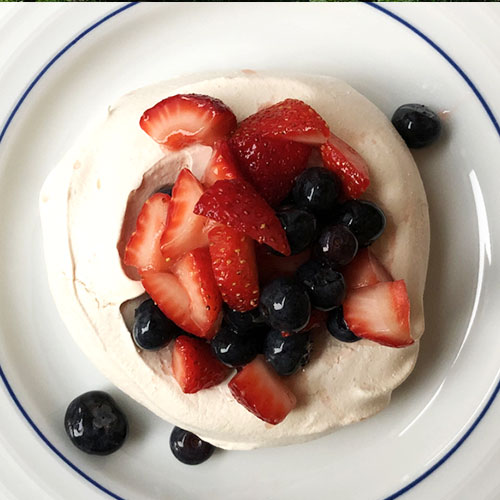How to Make Schaum Tortes
A family recipe for German meringues, Wisconsin-style
My grandma Ruth made schaum tortes for the sisters in the convent down the street.
Ruth’s father was Irish, her mother was from Alsace-Lorraine, and her husband was Slovak. So, basically, she was a Midwesterner. Like thousands of other Midwesterners, she learned to bake German meringues while growing up in Milwaukee in the 1920s
On schaum torte days, she whipped five simple ingredients—egg whites, sugar, vanilla, vinegar, and cream of tartar—into sturdy peaks and baked them low and slow, making palm-sized meringue nests that lived up to the meaning of their name: “foam cake.”
Once, in an act of great infamy, my aunt Mary Catherine snuck down to the kitchen and ate all the torte tops while Ruth was preparing to transport her creations to the St. Monica Convent. How could you blame her? Crisp on the outside and chewy on the inside, Ruth’s schaum tortes were light but substantial, with peaked-hat tops and air-pocketed bottoms that collected bits of macerated strawberry. Their white, plaster-like appearance made the simple act of consuming them feel transgressive, like eating a stucco shell off the wall of a rococo church.
Ruth’s father was Irish, her mother was from Alsace-Lorraine, and her husband was Slovak. So, basically, she was a Midwesterner. Like thousands of other Midwesterners, she learned to bake German meringues while growing up in Milwaukee in the 1920s
Wisconsinites make different kinds of schaum tortes. Some are piped in coils. Some come with ice cream, others with whipped cream. Some feature bananas instead of strawberries. (Sacrilege!) Although I now know that the schaum torte is the German relation of the French macaron, the Russian pavlova, and the English Eton mess, in childhood, I knew it only as a treat from my grandma’s kitchen and the occasional German restaurant.
The first time I tried to make Ruth’s tortes, I was baking for my friend Danie. After meticulously separating my egg whites, I realized that I had none of the cream of tartar required by the recipe and called home for advice. My mother went looking for the original index-card recipe, hoping that it might offer some guidance, but it was nowhere to be found… until it appeared, inexplicably, on my mother’s bedroom floor later that night. In Catholic-school handwriting, Ruth gently answered my question: “Pinch of cream of tartar (if you don’t have it’s all right).”
More than a decade after I received that ghostly cooking tip, I can make schaum tortes for special occasions with little handwringing. Ruth was a tolerant recipe writer, but these days, I do worry if I don’t have cream of tartar. In fact, after years of trial and error, I add a few pinches. Without it, this family heirloom dessert lacks the liminality of cracked sugar yielding to chewy center that tempted aunt Mary Catherine some sixty years ago in Ruth’s kitchen with the Dutch door on Bay Ridge Avenue.
Ruth’s Schaum Tortes
Makes 6-8, depending on size
Ingredients
3 egg whites, from room temperature eggs
1 cup of sugar
1 tbsp. vinegar
Pinch (or three) of cream of tartar
¼ tsp. vanilla extract
Fresh berries, to serve
Preparation
Preheat the oven to 275 degrees. Separate your eggs, taking care that not even a trace of yolk falls into your whites. Using a whisk or a mixer with a whisk attachment, beat egg whites into stiff peaks. Add sugar, vinegar, cream of tartar, and vanilla a little bit at a time and beat several minutes more, or until mixture is thick and glossy.
Place meringues on parchment-lined baking sheets, making mounds roughly three inches in diameter. You can bake whole and slice later to fill, as my grandma did, or press the middle down with a spoon to make room for toppings. Bake for 50-55 minutes, or until the outside is crisp but the inside still has some chew. Top with berries, fresh from a pint container or macerated in a bowl with sugar, lemon juice, and a pinch of salt until soft and syrupy.


